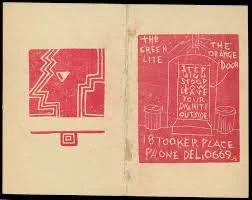The Dil Pickle Club: A Visual History
Dill Pickle Club, also spelled Dil Pickle Club, bohemian club, cabaret, and (from the mid-1920s) speakeasy in Chicago that operated from about 1914 to about 1933 (though sources vary). Its patrons included hoboes, prostitutes, and gangsters as well as leading scholars, literary figures, and social activists, among them writers Sherwood Anderson, Carl Sandburg, Theodore Dreiser, Ben Hecht, Kenneth Rexroth, and Upton Sinclair; activists Emma Goldman and Big Bill Haywood; and attorney Clarence Darrow. The club’s spirit was reflected in its orange alley door and its signage: beneath a sign that read “DANGER” and two arrows pointing to the club’s entrance ran the warning “Step High, Stoop Low, Leave Your Dignity Outside.”
The club’s origins are shrouded in myth, exaggeration, and confusion, much of that provided by its owner, John A. (“Jack”) Jones. A former union organizer for the Industrial Workers of the World (IWW), Jones in the early 1910s started a series of weekly forums at the Radical Book Shop, located on North Clark Street in Chicago, to talk about labour issues and other social concerns of the day. By 1917 Jones’s gatherings had exceeded the shop’s capacity, and Jones had relocated to a dilapidated barn at what is now Tooker Place, just off Dearborn Street, in what is today the Near North Side area of Chicago.
Modernist, Cubist, and other styles of revolutionary art decorated the club’s walls.
This book, a visual history of the Dil Pickle Club, told through printed ephemera, will accompany an exhibition at the Newberry Library, curated and edited by Paul G. Durica, J.C. Gabel, and Meghan McGrath.


